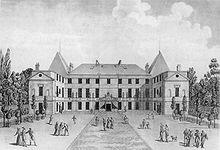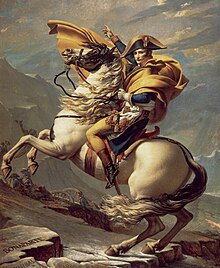Malmaison Castle
The Malmaison Castle ( French: Château de Malmaison ) in Rueil-Malmaison west of Paris was the residence of Emperor Napoleon and his wife Joséphine . While the imperial couple officially held court at the Palais des Tuileries , Malmaison became their private retreat.
history
The mala-mansio is mentioned for the first time as a royal villa (a son of Clovis I ) in the 6th century . From mala mansio then Malmaison ( "bad house" German).
A few hundred years later, a Scottish knight settled on the property. In the 14th century it came into the possession of the royal adviser Robert de Lorris, then Guillaume Goudet bought it. The actual manor house was not built by his descendants until the beginning of the 17th century.
Joséphine's country estate (1799–1814)
Purchase and use
From September 1793, Joséphine de Beauharnais, who would later become Napoleon's first wife, lived within sight of Malmaison. The castle was on the opposite side of the Seine from their residence in Croissy-sur- Seine . Malmaison was in a scenic location. Nearby, wooded slopes stretched almost to the river. There were also large lawns - ideal for creating flower gardens. The political framework also seemed to be favorable for Joséphine. Since the possessions of the nobility and clergy had been expropriated during the French Revolution , numerous estates, including the surrounding gardens, were for sale. Napoléon, to whom Joséphine had been married since 1796, also wanted to secure his fortune by owning land near Paris. However, Malmaison already belonged to a wealthy Parisian banking family who did not want to sell their country estate for a cheap price and had only recently invested in renovations. At Joséphine's urging, Napoleon visited Malmaison shortly before his Egyptian campaign . He offered the Molay family 250,000 francs for the castle. However, this demanded a minimum price of 300,000 francs, which Napoleon rejected. Joséphine finally used the absence of her husband, who was in Egypt, to buy Malmaison on April 21, 1799. This was preceded by tough negotiations with the banker's wife. Joséphine personally ran this with Napoléon's permission, but had not adhered to the financial limit he had set. Since she had to borrow money for the purchase that she could not repay, Joséphine soon had to rely on Paul de Barras ' help to fend off the debt collectors. It was not until the end of 1799 that Napoleon grudgingly paid off the 300,000 franc debt. Accordingly, Malmaison Castle actually belonged to Napoléon rather than his wife Joséphine.
Unlike the Palais des Tuileries, Malmaison Castle was not the official seat of Napoleon's government. Napoléon only visited the manor on weekends, while Joséphine stayed there in the summer months. In November 1799 the architects Fontaine and Percier were hired, two main representatives of the art movement of the Empire . Every time Napoléon visited, Fontaine and Percier had to complete another area of the castle, including the interior furnishings. After Joséphine's coronation as empress, construction work in the palace was initially stopped, as Joséphine had to head the imperial court in Paris when her husband was frequently absent due to the war. Only after her divorce from Napoleon did Malmaison become her main residence. The emperor awarded her Malmaison as sole property. The furnishings in their rooms were renewed until 1814, or when Joséphine died. Napoléon's apartments remained untouched by the renovation.
Rooms (selection)
The dining room was completely redesigned in 1800 by the architect Fontaine. Fontaine tore down the wall between the dining room and anteroom, creating a bright, approximately 80 m 2 large room with six windows. The white marble fountain (not shown in the picture) was originally crowned by a statuette of the Greek goddess Hebe . With this representation the fertility of Joséphine should be emphasized (see also Napoléon's problem of succession to the throne ). The hall could be heated thanks to several ovens in the basement. The equipment is almost completely preserved; an oval mahogany table , twelve chairs and two armchairs. The latter were reserved exclusively for Joséphine and Napoléon. The court had to be content with the chairs. The tiles are made of white and black marble. The painting of the room is based on ancient models or the Pompeian style . It is a representation of eight Pompeian dancers drawn on stucco by Louis Lafitte . The sketches for this go back to the architect Charles Percier.
Napoléon's study was one of the first rooms in Malmaison Castle to be completed in 1802 . Here he held regular ministerial meetings. The room was modeled on a Roman field tent, which is symbolically supported by lances and shields on the walls. On the door leaves there are paintings depicting trophy weapons from the Carthaginians, Romans, Greeks, Gauls, Dacians, Persians and Etruscans. This staging of images was intended to express that France has now succeeded the ancient "war peoples". Originally there were two beds at the side of the fireplace. But they are no longer preserved. In the center is the council table, around which ten armchairs, ten stools and six mahogany chairs are grouped. A twelve-lamp chandelier made of gold-plated bronze and crystal provided the lighting. There were three portraits on paintings in the room; one shows a military model of Napoléon, the Prussian King Frederick II , another Josephine's daughter Hortense with her two sons and a third Joséphine himself. The latter portrait goes back to the painter François Gérard .
The library is the last room designed in the palace by architects Percier and Fontaine. After differences of opinion with Joséphine, who was overseeing the construction work, both architects were recalled from Malmaison in 1802. The library was created by merging originally three smaller rooms. Thanks to the large number of decorative painters employed, the painting on the ceiling was completed in just 10 days. In the center of the painting are Apollo and Minerva, the patron saints of the fine arts. In this way, Joséphine indirectly alluded to her own role as an art patron . The two Roman deities are surrounded by portrait medallions of the writers and philosophers particularly valued by Napoléon, including Virgil , Dante, Homer, Terence, Ossian, Pindar, Xenophon, Socrates, Herodotus, Polybius, Voltaire and Raynal . Napoléon retired here mainly to various writing activities. In addition to the existing folding tables and desks, there were also various game tables on which, for example, Tric Trac could be played. The room was also used for social gatherings. Napoléon also collected his 750 medals in this room. A total of 4,500 books were stored in the cupboards.
The billiard room was used for evening entertainment, for which a mahogany billiard table and four other game tables (Tric Trac and Reversi ) were available. The imperial couple played here against officers and court ladies. Joséphine's first chambermaid, Marie-Jeanne-Pierrette Avrillon , wrote about this in her memoir: "After dinner, the Empress went into the billiards room, where she played a round or two and was extremely skilled". Napoléon, on the other hand, was reported to have mostly disregarded the rules of the game. The current furnishing of the room comes mainly from 1812, when the architect Louis-Martin Berthault carried out a renovation.
In 1804, Joséphine, a great lover of flowers (especially roses , which is why she is also known as the "Rose Empress"), began building the famous rose garden , which when she died contained all the known rose varieties of her time.
After her divorce Napoléon overrode her castle , where she received numerous visits, for example, the future Tsar of Russia Nicholas , Prince Wilhelm of Prussia , who after the French defeat of 1870 in Versailles for Kaiser was declared and the future Emperor of France , Napoléon III.
In Swiss historiography and literature, the provisional federal second constitution of the Helvetic Republic , drafted by Bonaparte in 1801, is referred to as the Malmaison constitution . The name indicates that the constitution was imposed on the Swiss parties by Bonaparte.
Time after Josephine
After Joséphine's death, her son Eugène inherited the castle . In 1842 the former Spanish Queen Maria Christina acquired the castle during her first French exile and sold it to Napoleon III in 1861 . further. Today it is a national museum and accessible on guided tours. It houses the probably original version of the painting by Jacques-Louis David , Bonaparte crossing the Alps on the Great Saint Bernhard .
literature
- Hans Walter Lack: Jardin de la malmaison. A garden for Empress Josephine . Prestel, Munich 2004, ISBN 3-7913-3050-0 .
Web links
- Castle website (English, French)
- Malmaison Castle as a 3D model in SketchUp's 3D warehouse
Coordinates: 48 ° 52 ′ 15 " N , 2 ° 10 ′ 0.5" E
Individual evidence
- ↑ Christophe Pincemaille: Malmaison, le jardin d'une femme. In: Joséphine. Réunion des musées nationaux, Paris 2014, ISBN 978-2-7118-6176-7 , pp. 24-25.
- ↑ Hans Ottomeyer : The invention of the style Empire. In: Maike Bartsch u. a. (Ed.): King Lustik. Jérôme Bonaparte and the model state Kingdom of Westphalia. Hirmer. Munich 2008, ISBN 978-3-7774-3955-6 , pp. 53-54.
- ^ Bernard Chevallier: Musée national des châteaux de Malmaison et Bois-Préau. Réunion des musées nationaux, Paris 2006, ISBN 2-7118-5180-X , p. 34.
- ^ Bernard Chevallier: Musée national des châteaux de Malmaison et Bois-Préau. Réunion des musées nationaux, Paris 2006, p. 28.
- ^ Bernard Chevallier: Musée national des châteaux de Malmaison et Bois-Préau. Réunion des musées nationaux, Paris 2006, p. 30.
- ^ Bernard Chevallier: Musée national des châteaux de Malmaison et Bois-Préau. Réunion des musées nationaux, Paris 2006, p. 9.






